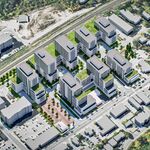robmausser
Senior Member
I think a signal priority could help a bit, but it would not solve the problem of too many surface crossing... With frequency of 5 min, we have two trains passing each intersection, each 2 m 30 sec. Minus time to cross (say 15 sec) and some buffer time to change the light (another 15 sec) it leaves only 2 min. So, if traffic light is green for left turns, there is a good chance that a train will need to stop anyway and then to wait for the crossing traffic...
I wonder if just smart traffic lights would help as well, especially during not busy times.
They are testing out smart traffic lights in my area (north of yonge and eg) and its really helped with the fact that this stretch of yonge has so many small intersections. In the past, the lights would change red on yonge and traffic would stop when no car or pedestrian was crossing, they just were on a timer.
Now with the smart lights, not only does it manage traffic better, but the lights on yonge never change red unless there is a car or a person wanting to cross.
Perhaps this would help the LRT line as well, for the above mentioned. Along with transit priority.
For example the smart lights use camera sensors, and would detect when there isnt a car turning left, so it would skip the left turn priority, allowing LRTs to move forward sooner, even if they get caught behind the transit priority.
The ground sensors alone arent reliable enough to do this, they still change the light to an advanced left, because sometimes they dont get tripped.
They can also do things like change a green light to red of an intersecting road faster when there are no more cars going through the intersection. So they also speed up dwell times, as you arent waiting for a light to change back to green when there are no more cars going the other way through the intersection.
All these things can help mitigate the dwell time when an LRT doesnt make it through transit priority, like in the example of another LRT ahead of it, etc.





